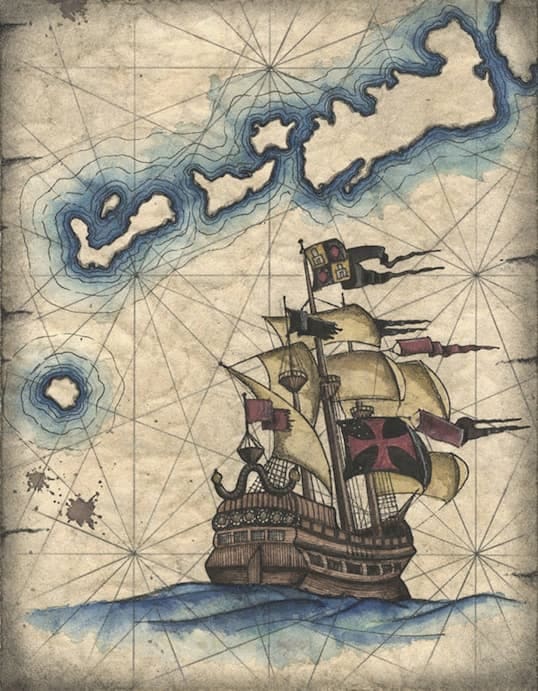The Age of Discovery in the New World was a result of a desire by Europeans to explore the seas for a more direct trade route to Asia, which led to the 1492 story of Christopher Columbus, who was recorded in history (letters and journal) as one of the initial explorers to reach the New World. After Columbus, exploration of the New World brought more European ships, more treasure hunters, more colonists, and unknown diseases.
- Post Contents -
FACTORS THAT INFLUENCED SEAFARING VENTURES in the Age of Discovery
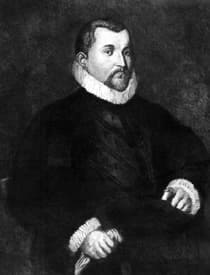
by Sir Antonio Moro
legendsofamerica.com
Technical advances in nautical development during the 15th century gave explorers better tools to navigate their ships for longer voyages. These improvements were in sailing and shipbuilding, nautical instruments, such as the magnetic compass, astrolabe, and quadrant as well as accurate nautical charts (cartography). Geographical factors such as the wind (e.g., northeast trade winds and westerly winds) and ocean currents also helped the explorers determine landfall locations as well as interior land probes.
Another factor that affected the Age of Discovery was the political changes that emerged from some European monarchs. Land possessions were unified, which increased taxes and enabled them to fund seafaring expeditions as well as to provide better naval support for military protection. With more monarch interest in the exploration of foreign trade and its profitability, their support became easier to obtain for this new generation of explorers.
Finding an easier route to China and India for their spices and merchandise was a much sought‑after quest during the 1400s, and Columbus was the first one known to have sailed westward to find the East. If other explorers during that time had sailed in the same westward direction and stayed on that course as Columbus did, they too would have encountered the New World. But it seemed even to Columbus, that it was unknown if other explorers had even tried the same westward route to the East. Columbus eventually admitted that he had not reached India or China and that he had stumbled onto an unknown body of land, yet he still believed that he had reached the Pacific Ocean. And although Columbus never found gold or silver from his voyages, he was commended by Spain and much of Europe as the discoverer of the western route to the East.
EUROPEAN EXPANSIONISM in the age of discovery
Besides power and territory, another reason for European expansionism was the competition between Catholic and Protestant nations. English Protestants feared that Spain would catholicize non-Christians in new lands and Spanish Catholics feared England would teach their Protestant untruths in new lands. Such intense religious suspicions provoked monarchs to invest more from their treasuries in seafaring expeditions so that they could extend their ideology in new colonies in new territories. The rise of Protestantism and the Catholic Church’s Counter-Reformation along with the Renaissance period gave the Age of Discovery a favorable environment for exploration.
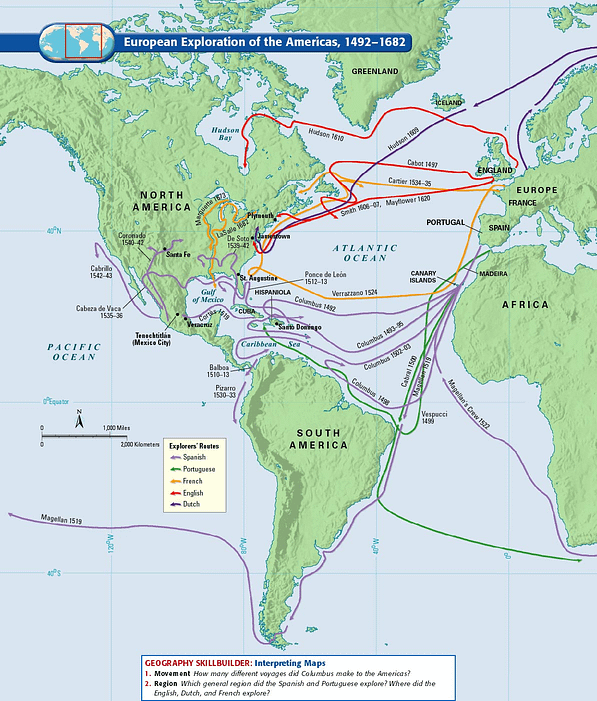
After Columbus’s discovery of the New World, England’s King Henry VII issued on 5 March 1497 to the Cabot family (John Cabot [Venetian Giovanni Caboto – b. ~1450 and d. ~1499 or 1500 / both unconfirmed] and his three sons, Lewis, Sebastian, and Sancio) a patent to uncover regions to the east, the west, and the north for England, avoiding all claims by Portugal. Cabot made two reconnaissance voyages, the first one from Bristol, England on 2 May 1497 with a crew of 18, sighting land (24 June) in the vicinity of Newfoundland and taking possession of the area for King Henry VII. He also sailed along the coast to Maine before returning to England. The second voyage in May 1498, Cabot left Bristol for Japan and the Spice Islands through Newfoundland and, it seems from the Hajeda patent of 8 June 1501, Cabot then explored the coast of North America as far south as Delaware or the Chesapeake Bay.
Although there has been no concrete evidence that Cabot ever returned to England from his last voyage in 1498, there was a map, however, from Juan de la Cosa (1460-1510; Spanish navigator and cartographer). This map indicated someone had returned and also showed that the Atlantic coast most likely had been explored as far south as Florida.
From 1501 to 1504 there were Anglo-Portuguese merchant voyages from Bristol, England under King Henry VII (patent letters of 19 March 1501) that were presumed to have made two transatlantic voyages. Another patent, dated 9 December 1502, was granted to a group known as the “Company of Adventurers to the New Found Lands,” who made annual voyages to the New World from 1502 through 1505, possibly as far south as the Middle Atlantic states.
Although Amerigo Vespucci (1451-1512; Italian navigator and for whom America was named [by geographer, Martin Waldseemüller]) is claimed to have played a major part in the exploration of the New World — it must be for South America because the only area he may have visited near North America that I can find is the Gulf of Mexico, and possibly as far north as the Gulf of St. Lawrence, Canada.
Juan Ponce De Leon – Florida and Puerto Rico
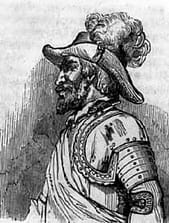
Discovered Florida
legendsofamerica.com
The next main explorer connected to North America during the Age of Discovery is Juan Ponce de León (b. ~1460 or 1474 – d. 1521), the conqueror of Puerto Rico and the discoverer of Florida. He also accompanied Columbus on the second voyage to America in 1493.
On 3 March 1513, Ponce de León set sail with his three-vessel fleet (Santiago, Santa María de la Consolación, and a galley like craft, the bergantín San Cristóbalon) from Puerto Rico, and on 27 March 1513 during the time of the Easter feast (Pascua Florida), Florida was discovered. The Spaniards decided to name the land “La Florida.”
On 2 April 1513, Ponce de León reached the Florida coast somewhere between St. Augustine and the St. John’s River. The next day, 3 April 1513, Ponce de León and his landing party went ashore. It is mentioned that after a short stay along the coast of St. Augustine, Ponce de León turned his ships south and explored the eastern coast of Florida all the way to Key West. He continued his journey up the west coast of Florida to Cape Romano and then to Charlotte Harbor (23 May 1513). Ponce de León then retraced his route back to the Florida Keys and Miami Bay where he sailed for the Bahamas. He returned to Puerto Rico on 21 September 1513.
In September 1514, the king of Spain commissioned Ponce de León to conquer and colonize the isles of Bimini and Florida. He finally sailed for Florida in 1521 with two ships, 200 men, 50 horses, and various other domestic animals, including farm tools. He landed on the west coast of Florida, supposedly Charlotte Harbor, where his landing party was ruthlessly attacked by Indians and he was mortally wounded by an arrow. The ships immediately sailed for Cuba, where Ponce de León died soon after.
Other Spanish Explorers To North America During the Age of Discovery
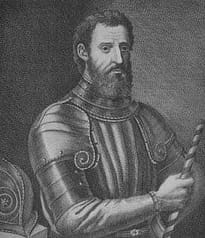
Explorers of the New World
ncpedia.org
The Spanish explorers that followed Ponce de León from 1521 to 1530 to North America, included Francisco de Gordillo, who sailed along the Atlantic coast from Florida to South Carolina (1521); Esteban Gómez, a Portuguese cartographer and explorer who sailed at the service of Spain from Nova Scotia to Florida (1524); and Pedro de Quejo, a slave trader, who also sailed the same route as Francisco de Gordillo along the Atlantic coasts of Virginia, the Carolinas, and Georgia (1524-1525).
Giovanni da Verrazano (1480-1528) was a Florentine explorer who sailed under the French service of Frances I-King of France. He set sail on his ship, La Dauphine, west from Madeira, Portugal (January 1524), and reached North America along the Carolina coast in March, reportedly Cape Fear, North Carolina. He set sail again along the North American coast, but this time he proceeded northward reaching New York Harbor in April, and Narragansett Bay in May. He continued north toward Nova Scotia before returning to France. Verrazano’s report to King Frances I (18 July 1524) was the chief source of information regarding this expedition.
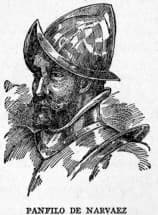
Explorers of the
New World
marinersmuseum.org
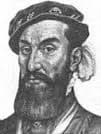
Cabeza de Vaca floridahistory.com
Pánfilo de Narváez (1478-1528) was a Spanish explorer who set sail from Spain for North America in 1527 with a fleet of five boats and 600 men. Desertions and storms delayed the expedition, and they did not reach the Florida coast (near Tampa Bay) until April 1528. After landing with approximately 400 men, Narváez sent his ships to a harbor that the pilots claimed to know near the Río de las Palmas (Mexico). They proceeded inland to search for gold and they reached the village of Apalachee (25 June) near present-day Tallahassee. Not finding any gold and then having to deal with Indian trouble, Narváez and his men turned back to the coast.
After reaching the coast, they constructed several crude sailing vessels so that they could attempt to reach Mexico. A few men survived the journey and reached Mexico City (1536), one of whom was Cabeza de Vaca, but the rest were either lost off the coast of Texas because of a shipwreck or after landing among hostile Indians.
Commentary
Driven by curiosity, fantasy, greed, and power, these early explorers from England, Portugal, Italy, France, and Spain sailed in search of knowledge and riches, and in doing so westernized the globe. These hardy adventurers had courage and willpower to seek beyond the unknown. They lived in a period of time that transformed a medieval age to a more modern age where changing faiths and cultures clashed. They were strongly influenced by traditions and superstitions of the Middle Ages, yet they remained determined to venture out beyond the fearful to seek adventure and knowledge.
Their spectacular exploits became folklore. Unfamiliar sea creatures and mysterious islands and lands inhabited by strange life forms. Mysterious realms beyond the setting sun were told and retold as a dangerous and enchanting utopia, where beautiful women, riches, power, and exciting adventures could be found.
However…the importance of the Greenland Viking voyages to Vinland and Markland over a thousand years ago revealed the fifteenth-century discovery of America as a seafaring expedition along old, long-traveled and tested routes of the Norsemen. Columbus’s knowledge of these Viking routes most likely increased his confidence of the existence of a large land mass in the western ocean, which would have removed the fear of sailing in an infinite sea where there would be no land, fresh water, or provisions. This is not to say that Columbus did not make an historical achievement in the discovery of America but, rather, followed an old trail that was passed down.
I also found in my readings there was little doubt that the east coast of America already had been reached by Northmen, in particular, Leif Ericson (elder son of Eric the Red, founder of Greenland) and Thorfinn Karlsefni (Icelandic merchant). It is recorded that their explorations occurred during the early years of our millennium, specifically Leif Ericson’s expedition in the early summer of 1000. He was claimed to be the main Nordic discoverer of the New World.
But another Northman, Bjarni Herjulfsson, reportedly voyaged from Iceland in 985 for Greenland and was thrown off course because of unfavorable weather; gray sky and a northerly wind sent his ship in a south‑westerly direction that carried his ship southwest. When he was finally able to get his bearings again on a clear day, he decided to sail westward since Greenland was west of Iceland. According to evidence cited, the land he sighted was the southern part of Baffin Island and was recorded as the first Norse explorer to sight North America in 985.
See post “Viking Exploration of North America” for more information.
Updated 2020
References
Ansley, Clarke F. (Ed.). 1935. The Columbia Encyclopedia: In One Volume. Columbia University Press, New York.
Chicora Indian Tribe of South Carolina
Hoffman, Paul E. 1984. The Chicora Legend and Franco-Spanish Rivalry in La Florida. The Florida Historical Quarterly. 62 (4): 419–438. JSTOR 30146593
Encyclopedia of World Biography.
http://www.notablebiographies.com/Tu-We/Vespucci-Amerigo.html
Florida Center for Instructional Technology. 2005.
http://fcit.usf.edu/Florida/docs/d/denarvaez.htm
Florida Department of State, Institute of Museum and Library Services. 2013.
http://floridamemory.com/blog/2013/04/15/panfilo-de-narvaez/
Hermann, P. 1954. Conquest by Man. Published in Germany under the title: Sieben Vorbei Und Acht Verweht.Ifland, Peter. 2000. Presentation at the Amphitheater of the Physics Museum under the auspices of the Pro-Rector for Culture and Committee for the Science Museum of The University of Coimbra.
http://www.mat.uc.pt/~helios/Mestre/Novemb00/H61iflan.htm
Lewis, J.D. 2007. http://www.carolana.com/Carolina/Explorers/gordillo_quejo.html
Miers, Earl Schenck (ed.). 1956. The American Story: The Age of Exploration to the Age of the Atom.
Miller, William. 1958. A New History of the United States.
Morris, Richard B. (ed.). 1953. Encyclopedia of American History.
New Advent Catholic Encyclopedia. http://www.newadvent.org/cathen/15384b.htm
Shaer, Matthew. 2013. Smithsonian magazine.
http://www.smithsonianmag.com/history-archaeology/Ponce-De-Leon-Never-Searched-for-the-Fountain-of-Youth-208345831.html
St. Augustine, Ponte Vedra, & The Beaches Visitors and Convention Bureau. 2013.
http://www.floridashistoriccoast.com/ponce_de_leon/
http://onlinecampus.fcps.edu/media2/Social_Studies/WHGII_2010/Era6Topic3_1/page_555.pdf
